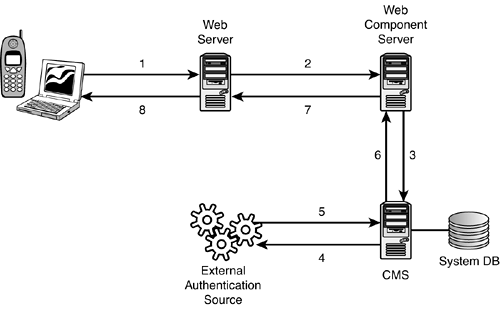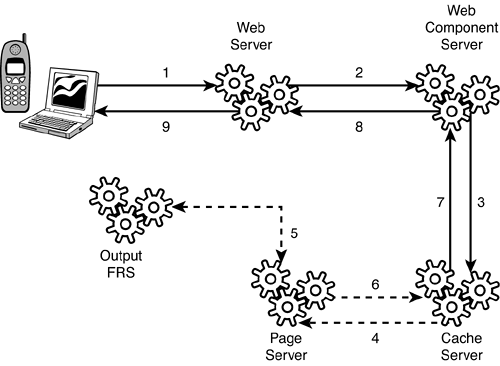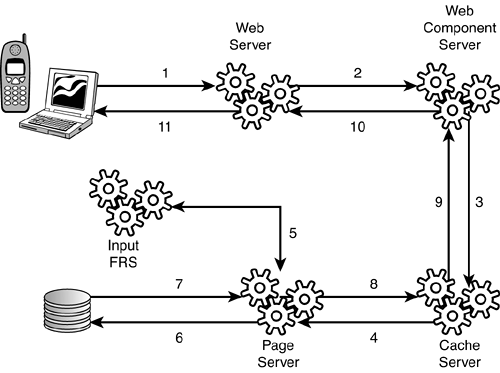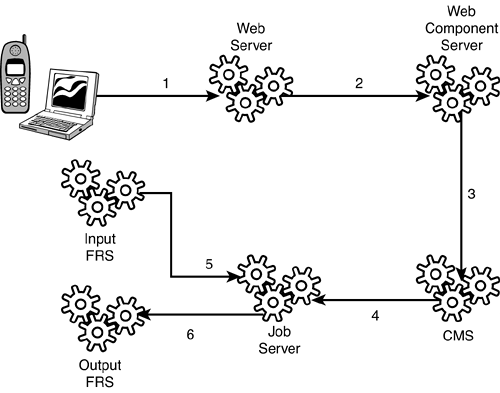The Crystal Enterprise Architecture in Action
This section takes a look at how all the Crystal Enterprise services come together and which of the services are used when a user requests objects. Each scenario is based on the following situation: Over a corporate intranet site, a user is browsing a Web page that connects him to a Crystal Enterprise system. The user has provided proper login credentials and is logged into Crystal Enterprise. He has been presented with a list of report objects that he has rights to access.
For this scenario to occur, a browser has connected to a Web server, and in turn the Web server passes the processes the Web page. For instance, if the page is written in JSP, the Java application server passes a request to the Crystal Enterprise Framework via the CE-SDK classes loaded on that application server. The continued interaction between the user and Crystal Enterprise Framework occurs through the facility of the CE-SDK on the application server.
If you are using the CSP pages provided in a COM environment, the Web Connector running on the Web server intercepts the file request because it has a .csp extension, and passes this request to the WCS for processing. The .csp is processed and in this scenario, the page asks the user for logon credentials and is returned to the user to complete. The credentials are submitted and passed to the WCS. The WCS now takes this information and attempts to log on to the CMS using the security service. After the user is logged on to Crystal Enterprise, the CMS is queried to present a list of folders and reports to the user. (The query is generated within the CSP page as well.) This scenario diagram can be seen in Figure 24.4.
Figure 24.4. The login process for a user validated by Crystal Enterprise.

For simplicity, the following examples will use the COM environment. To determine how this would relate to the Java or .Net environments, the role of the WCS and Web Connector would be replaced with the CE-SDK running on the appropriate server. The CE-SDK, loaded into the server, communicates directly with the Crystal Enterprise Framework.
NOTE
The numbered flow in Figures 24.4, 24.5, 24.6, and 24.7 represents the flow of information and requests to get a report processed and delivered to the end user. Dashed lines in the figures represent optional steps.
Figure 24.5. The report-loading process in Crystal Enterprise.

Figure 24.6. The report loading process for on-demand viewing.

Figure 24.7. The process for scheduling reports.

Requesting a Crystal Report
The user in the preceding scenario has two methods of viewing a report.
The first method is to view an instance of a previously scheduled job. If an instance is chosen, the report contains cached data from when the job was run. When the request to view the report is received, the WCS asks the Cache Server if the first page of this report is available in cache. If the first page is available, the Cache Server returns the page to the WCS so it can be delivered to the report viewer. The report viewer then displays the report for the user. If the page is not in the cache, the request is forwarded onto the Page Server to generate the page.
As Figure 24.5 shows, when the Page Server receives the request, it loads the report from the output File Repository Server. After the Page Server loads the report, it generates the page that has been requested and then passes it back to the Cache Server. The Cache Server sends the page onto the WCS to be given to the report viewer.
The second method for viewing a report is to view the report itself, which is also known as on-demand viewing. If a user selects the report itself, she must first have the "view on demand" access level. When the report is requested it goes through the same process as shown in Figure 24.5; however, because the report does not have any cached data within the report like the instance has, the Cache Server passes the request directly onto the Page Server.
Figure 24.6 shows the extra steps required for on-demand viewing. The Page Server queries the input FRS for the report and loads it. After the report loads, the user will be asked to enter the database logon information and any parameters for the report to run. The Page Server then passes this information to the Crystal Reports engine through the report plug-in. The Crystal Reports engine connects to the database and queries for the necessary data. After the data has been returned to the report engine, the report is recalculated and page information is determined. The Page Server now generates the first page of this report and sends it to the Cache Server, which in turn passes it to the WCS and then to the report viewers.
In both scenarios of viewing a Crystal Report, if a processing extension is being used with this report, the cache is then not sharable. The Cache Server will pass the request directly to the Page Server. The Page Server will load the report from the FRS. During the time that the report is being loaded, the processing extension is engaged to determine the proper row-level restrictions that need to be applied to the cached data within the report. The cached data is then filtered and the page is generated with information that is viewable by that user only.
Scheduling a Crystal Report
When a report is scheduled, Crystal Enterprise requires the appropriate information so that the scheduling service knows what tasks are to be performed. Figure 24.7 depicts a typical scenario where an end user schedules a report with the appropriate criteria set. This information is passed to the WCS, which in turn forwards the information to be stored in the CMS. The schedule is set to run at a particular point in the future. When the schedule time occurs, the CMS loads the information from the repository and submits the request to a Job Server. The Job Server asks the input FRS for the report and then loads it into the report Job Server plug-in.
With the report loaded, the Job Server applies any of the parameters set when the user scheduled the report earlier. These parameters might be filters that affect the overall data query. If a processing extension is in use, the report would be further manipulated. After the processing extension is finished with the report, the Job Server connects to the database and completes the processing of the report.
When the job has completed, the Job Server checks two remaining pieces of information the user would have set when scheduling the report; the format in which the report is to be delivered and where it will be delivered. At this stage, the Job Server would output the report into a supported Crystal Enterprise format, including Crystal Reports, Microsoft Word, Excel, Adobe Acrobat, Rich Text Format, or text.
NOTE
The default output format for all Crystal Enterprise servers is Crystal Reports.
Next, the Job Server needs to distribute the report to the desired location. As previously mentioned, these locations can be a location on disk, an FTP server, or an e-mail address, or remain in the managed Crystal Enterprise environment by distributing it to the output FRS as a report instance object. Regardless of where the user decides to distribute the object, a copy is always stored in the output FRS so that it can be shared between users.
Requesting a Crystal Analysis Report
If an organization is using Crystal Analysis Professional, it's important to note that report viewing is handled differently from a Crystal Report. Requesting a Crystal Analysis report starts by the user clicking on a link to the report in a Web browser.
The request is delivered to the WCS, and it asks the CMS for the object that was asked for. The object is returned to the WCS and then is loaded by the Crystal Analysis engine. The reports created in Crystal Analysis are dynamic queries to a multidimensional cube of datathe CA engine must connect to the cube referenced in the report.
After a connection to the cube is made, data is retrieved and populated into the .car file, which is an XML document. This XML document is transformed through a style sheet into DHTML and delivered as the first view of the report. This information is sent from the WCS to the Web browser along with the Crystal Analysis DHTML viewer. The viewer makes additional requests for data from the cube via the WCS as it is needed to populate the view of the report.
Part I. Crystal Reports Design
Creating and Designing Basic Reports
- Creating and Designing Basic Reports
- Introducing the Crystal Reports Designer
- Understanding Data and Data Sources
- Introduction to the Data Explorer
- Adding Database Objects to Your Report
- Joining Database Objects Together
- Understanding the Different Join Types
- Using the Report Creation Wizards
- Understanding the Crystal Reports Gallery
- Using the Standard Report Creation Wizard
- Creating a Report Without Wizards
- Troubleshooting
Selecting and Grouping Data
- Selecting and Grouping Data
- Introduction
- Understanding Field Objects
- Working with Groups
- Understanding Drill-down Reports
- Troubleshooting
Filtering, Sorting, and Summarizing Data
- Filtering, Sorting, and Summarizing Data
- Introduction
- Filtering the Data in Your Report
- Learning to Sort Records
- Working with the Sort Expert
- Creating Effective Summaries
- Troubleshooting
Understanding and Implementing Formulas
- Understanding and Implementing Formulas
- Introduction
- Using the Formula Workshop
- Using the Workshop Formula Editor
- Creating Formulas with the Formula Expert
- Using the Formula Extractor to Create Custom Functions
- The Multi-Pass Reporting Process of the Crystal Reports Engine
- Troubleshooting
Implementing Parameters for Dynamic Reporting
- Implementing Parameters for Dynamic Reporting
- Introduction
- Understanding the Value of Parameters
- Creating and Implementing Parameters Fields
- Using Parameters with Record Selections
Part II. Formatting Crystal Reports
Fundamentals of Report Formatting
- Fundamentals of Report Formatting
- Introduction
- Positioning and Sizing Report Objects
- Modifying Object Properties for Formatting Purposes
- Exploring the Format Editor Dialog Common Options
- Combining and Layering Report Objects
- Configuring Report Page and Margin Properties
Working with Report Sections
- Working with Report Sections
- Introduction
- Formatting Report Sections
- Modifying Report Section Properties
- Using Multiple Report Sections
- Troubleshooting
Visualizing Your Data with Charts and Maps
- Visualizing Your Data with Charts and Maps
- Introduction to Charts and Maps
- Using the Chart Expert
- Using the Map Expert
- Modifying Chart and Map Properties
- Troubleshooting
Custom Formatting Techniques
- Introduction
- Making Presentation-Quality Reports
- Common Formatting Features
- Conditional Formatting Using Data to Drive the Look of a Report
Part III. Advanced Crystal Reports Design
Using Cross-Tabs for Summarized Reporting
- Using Cross-Tabs for Summarized Reporting
- Introduction to Cross-Tabs
- Benefits of Cross-Tabs
- Using the Cross-Tab Wizard
- Using Top N with Cross-Tabs Reports
- Using Advanced Cross-Tab Features
Using Record Selections and Alerts for Interactive Reporting
- Using Record Selections and Alerts for Interactive Reporting
- Creating Advanced Record Selection Formulas
- Adding Alerting to Your Reports
- Performance Monitoring and Tuning
Using Subreports and Multi-Pass Reporting
- Using Subreports and Multi-Pass Reporting
- Understanding Subreports
- Understanding Linked Versus Unlinked Subreports
- Considering Subreport Execution Time and Performance
- Using Variables to Pass Data Between Reports
- Emulating Nested Subreports
- Troubleshooting
Using Formulas and Custom Functions
- Using Formulas and Custom Functions
- Becoming More Productive with Formulas
- Choosing a Formula Language: Crystal Versus Basic Syntax
- Using Brackets in Formulas
- Using Characters in Formulas
- Recent Improvements to Formulas
Designing Effective Report Templates
- Designing Effective Report Templates
- Understanding the Importance of Reuse in Reporting
- Understanding Report Templates
- Using Report Templates
- Using Existing Crystal Reports as Templates
- Understanding How Templates Work
- Creating Useful Report Templates
- Using Template Field Objects
- Using Report Templates to Reduce Report Creation Effort
- Applying Multiple Templates
Additional Data Sources for Crystal Reports
- Additional Data Sources for Crystal Reports
- Understanding the Additional Crystal Reports Data Sources
- Connecting to COM-based Data Sources
- Connecting to Java-based Data Sources
- Understanding Solution Kits for Crystal Enterprise
- Troubleshooting
Multidimensional Reporting Against OLAP Data with Crystal Reports
- Multidimensional Reporting Against OLAP Data with Crystal Reports
- Introduction to OLAP
- OLAP Concepts and OLAP Reporting
- Recently Added or Changed OLAP Features in Crystal Reports
- Using the OLAP Report Creation Wizard and OLAP Expert
- Advanced OLAP Reporting
- Introduction to Crystal Analysis
Part IV. Enterprise Report Design Analytic, Web-based, and Excel Report Design
Introduction to Crystal Repository
- Introduction to Crystal Repository
- What Is the Crystal Repository?
- Why Implement the Crystal Repository?
- Installing the Crystal Repository
- Adding Objects to and from the Repository
- Migration of the Crystal Enterprise Repository
- Troubleshooting
Crystal Reports Semantic Layer Business Views
- Crystal Reports Semantic Layer Business Views
- Introduction to Business Views
- Why Implement Business Views?
- Performance and Implementation Considerations
- Business Views Architecture and Implementation
- Troubleshooting
Creating Crystal Analysis Reports
- Creating Crystal Analysis Reports
- Introduction
- Introducing Crystal Analysis
- Accessing OLAP Data with Crystal Analysis
- Designing Crystal Analysis Reports and Applications
- Adding Crystal Analysis Objects to a Report
- Troubleshooting
Advanced Crystal Analysis Report Design
- Advanced Crystal Analysis Report Design
- Introduction
- Advanced Crystal Analysis Designer Tools
- Custom Calculations and Advanced Data Analysis
- Setting Report Options
- Troubleshooting
- Crystal Analysis in the Real World MDX
Ad-Hoc Application and Excel Plug-in for Ad-Hoc and Analytic Reporting
- Ad-Hoc Application and Excel Plug-in for Ad-Hoc and Analytic Reporting
- Introducing Ad-Hoc Reporting Conceptually
- Introducing the Crystal Enterprise Ad-Hoc Reporting Application
- Crystal Reports Excel Plug-in
- Crystal Analysis Excel Plug-in
Part V. Web Report Distribution Using Crystal Enterprise
Introduction to Crystal Enterprise
- Introduction to Crystal Enterprise
- What Is Crystal Enterprise?
- Why Implement a Crystal Enterprise Solution?
- Versions of Crystal Enterprise
- Understanding the Core Functions of Crystal Enterprise
Using Crystal Enterprise with Web Desktop
- Using Crystal Enterprise with Web Desktop
- Introduction
- Crystal Enterprise User Launchpad
- Crystal Enterprise Web Desktop
- Customizing the Web Desktop and Report Viewers
- Publishing to the Web Desktop
- Customizing the Web Desktop
- Troubleshooting
Crystal Enterprise Architecture
- Crystal Enterprise Architecture
- Introduction
- Crystal Enterprise Architecture Overview
- The Client Tier
- The Application Tier
- The Server Tier: Introduction to the Crystal Enterprise Framework
- The Server Tier: Overview of the Crystal Enterprise Services
- The Data Tier
- The Crystal Enterprise Architecture in Action
- Taking Advantage of the Crystal Enterprise Distributed Architecture
- Extending Crystal Enterprise
Planning Considerations When Deploying Crystal Enterprise
- Planning Considerations When Deploying Crystal Enterprise
- Ensuring a Successful Crystal Enterprise Implementation
- Approaching the Project
- Identifying Business Pain
- Establishing Project Requirements
- Understanding Organizational Reporting Requirements
- Troubleshooting
Deploying Crystal Enterprise in a Complex Network Environment
- Deploying Crystal Enterprise in a Complex Network Environment
- Introduction
- Understanding Network Protocols
- Understanding Firewall Types
- Configuring the Crystal Enterprise Architecture for Your Network Environment
- Interaction Between the WCS and the WC
- Deploying Crystal Enterprise with an IP Packet Filtering Firewall
- Using Crystal Enterprise with NAT
- Exploring the NAT and Crystal Enterprise Relationship
- Crystal Enterprise and Proxy Servers
Administering and Configuring Crystal Enterprise
- Introduction
- Using the Crystal Management Console
- Managing Accounts
- Managing Content
- Introducing Servers
- Managing Crystal Enterprise System Settings
- Using the Crystal Configuration Manager
Part VI. Customized Report Distribution Using Crystal Reports Components
Java Reporting Components
- Java Reporting Components
- Overview of the Crystal Reports Java Reporting Component
- Understanding the Java Reporting Components Architecture
- Differences with the Java Reporting Engine
- Configuring the Application Server
- Delivering Reports in Web Applications
- Using the Crystal Tag Libraries
- Exporting Reports to Other File Formats
- Printing Reports from the Browser
- Common Programming Tasks
- Troubleshooting
Crystal Reports .NET Components
- Crystal Reports .NET Components
- Understanding Microsofts .NET Platform
- Understanding the Different Crystal .NET Components
- An Overview of the Crystal Reports 10 .NET Components
- The Report Designer
- The Report Engine Object Model
- Delivering Reports with the Windows Forms Viewer
- Delivering Reports with the Web Forms Viewer
- Database Credentials
- Setting Parameters
- Troubleshooting
COM Reporting Components
- COM Reporting Components
- Understanding the Report Designer Component
- Building Reports with the Visual Basic Report Designer
- Programming with the Report Engine Object Model
- Delivering Reports Using the Report Viewer
- Troubleshooting
Part VII. Customized Report Distribution Using Crystal Enterprise Embedded Edition
Introduction to Crystal Enterprise Embedded Edition
- Introduction to Crystal Enterprise Embedded Edition
- Introduction to Crystal Enterprise Embedded Edition
- Understanding Crystal Enterprise Embedded Edition
- Crystal Enterprise Embedded Edition Samples
- DHTML Report Design Wizard
- Troubleshooting
Crystal Enterprise Viewing Reports
- Crystal Enterprise Viewing Reports
- Viewing Reports over the Web
- Introduction to the Crystal Report Viewers
- Understanding the Report Source
- Implementing the Page Viewer
- Implementing the Part Viewer
- Implementing the Interactive Viewer
- Implementing the Grid Viewer
- Troubleshooting
Crystal Enterprise Embedded Report Modification and Creation
- Introduction
- Deploying RAS Environments
- Loading Report Files
- Locating RAS Components in a Network Architecture
- Installing the RAS SDK
- Best Practices in RAS Exception Handling
- The RAS SDK in Action
Part VIII. Customized Report Distribution Using Crystal Enterprise Professional
Introduction to the Crystal Enterprise Professional Object Model
- Introduction to the Crystal Enterprise Professional Object Model
- Understanding the Crystal Enterprise Object Model
- Establishing a Crystal Enterprise Session
- Querying the Crystal Enterprise Repository
- Viewing Reports
- The Crystal Enterprise Java SDK
- Accessing the Java SDK
- Troubleshooting
Creating Enterprise Reports Applications with Crystal Enterprise Part I
- Creating Enterprise Reports Applications with Crystal Enterprise Part I
- Advanced Scenarios with the Crystal Enterprise Object Model
- Scheduling Reports
- Scheduling to a Destination
- Using Crystal Enterprise Notifications
- Scheduling to a Server Group
- Scheduling to a Specific Format
- Setting Database Credentials
- Troubleshooting
Creating Enterprise Reporting Applications with Crystal Enterprise Part II
- Creating Enterprise Reporting Applications with Crystal Enterprise Part II
- Querying the Crystal Enterprise InfoStore
- Creating and Responding to Crystal Enterprise Alerts
- Creating Schedulable Program Objects
- Troubleshooting
Appendix A. Using Sql Queries In Crystal Reports
Creating Enterprise Reporting Applications with Crystal Enterprise Part II
EAN: 2147483647
Pages: 341
- ERP Systems Impact on Organizations
- Challenging the Unpredictable: Changeable Order Management Systems
- Intrinsic and Contextual Data Quality: The Effect of Media and Personal Involvement
- Relevance and Micro-Relevance for the Professional as Determinants of IT-Diffusion and IT-Use in Healthcare
- Development of Interactive Web Sites to Enhance Police/Community Relations
